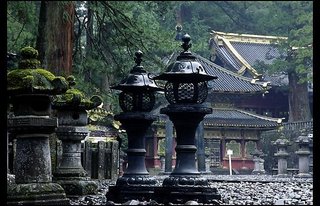
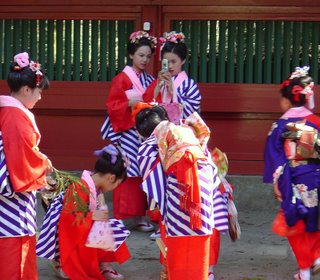
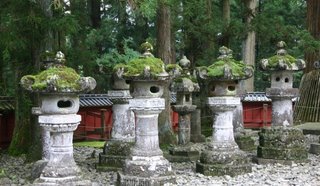


The Yomeimon, probably the most famous work of architecture in Nikko, was erected in 1636 and has been maintained through repeated roofing repair and painting repair to keep it in a condition equal to that at the time of original construction, including its decorative sculpture and other decorative members. It is the most elegantly decorated among the shrine buildings of Toshogu. The great extent of decorative effort peculiar to this particular construction can be seen in the fact that even the structural members are decorated with patterns and sometimes ornamented with sculptures on the surface. Admirable workmanship is recognizable in the decorative expressions produced through a combination of painting, coloring and metal fittings carefully selected in consideration of the subjects or motifs to be expressed in them and the durability of the materials.

The Karadou-torii has been made of bronze, and it is 6m high.The Karadou-torii was the first bronze Torii in Japan. The third successive shogun Iemitsu spent 200,000,000 yen in today's currency. Lotus flower is carved on the foot of the pillars. It is strange that lotus is seen in the shrine because that flower is related to Buddhism.
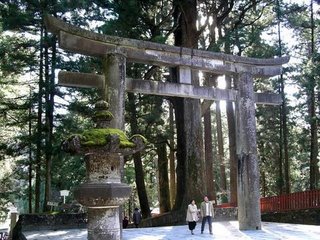
The Ishidorii has remained in its original form since its construction in 1618. The torii gate, which is 9.2 m tall and 13.2 m wide, is made out of 15 blocks of stone, instead of wood, which is the material usually used for torii. The Ishidorii has a unique structure well designed to resist earthquakes; the primary top rail and the secondary top rail, called Kasagi and Shimaki, are hollowed in order to minimize the weight and a pair of grafted stone columns are set firmly to support them.

The Shinkyo, or the sacred bridge, is known to have existed already on the present site spanning the Daiya River in the Muromachi Period (according to remaining archival records) though the exact date of its construction is not clear. It was in 1636 that this bridge took on its present style as a vermilion-lacquered wooden bridge on massive stone piers piled down close to the riverbanks. Though demolished in a flash flood in 1902, it was reconstructed and restored to its 17th -century condition in 1904.

Mt. Nantai, Lake Chuzenji, Nikko National Park. This lake is located about an hour drive in to the mountains from the main town of Nikko. It is up one of the craziest and windiest roads I have ever been on. It is definitely a must see. Below is more information on this area:Generally speaking, central Nikko is recognized as Nikko while area of Lake Chuzenji, around Mt. Nantai and Yumoto are called Oku-Nikko (Inner Nikko), but some people call it just Yumoto area. Border between Nikko and Oku-Nikko is Byoubuiwa rocky screen on the Irohazaka winding road.There are some stories regarding name of Futara. Mt. Nantai is also called Mt. Futara, and the name of Futara is derived from Potalaka in Sanskrit. Also, Futara can be divided into two Japanese words. One is futa, which means two in Japanese, and another word is ara, which means storm. The meaning of combination of those two words are two storms. According to a legend, god of wind and god of thunder appear at Byoubuiwa rocky screen and bring the two storms a year. Moreover, Futara can be pronounced Nikoh in another way of reading. You can imagine that the Nikoh became Nikko later.Landscape of Oku-Nikko has been created dramatically by natural environment like an eruption. Lake, waterfall, grassy plain and marshland are gathered like a miniature garden. Nature has been remained its natural appearance since Oku-Nikko was designated as a National Park in 1934. History of Oku-Nikko began when Priest Shoto succeeded to climb the Mt. Nantai in Nara-Heian period. Nikko developed as a training area for ascetics until Edo period, and developed as a resort area from Meiji era.Weather of Oku-Nikko is relatively cold, but it is comfortable to spend the summer. Plants change their appearances in every season. You should bring chain for your tires when you come to Nikko by the car from December to March. Snow will not be heavy, but surface of the road will possibly be frozen.
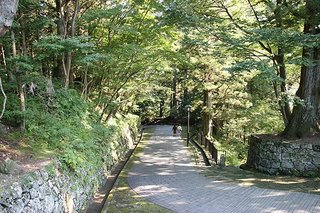


The Gojunoto is an 1818 reconstruction of the original five-storied pagoda, which was erected in 1650, but which was lost in a fire in 1815. In order to make the tower stable enough to resist wind and earthquake forces, the center pillar is suspended on the fourth story and held 10 cm above the ground -- not resting on a foundation stone -- thereby functioning as a dynamic counterweight which maintains the center of gravity.

No comments:
Post a Comment